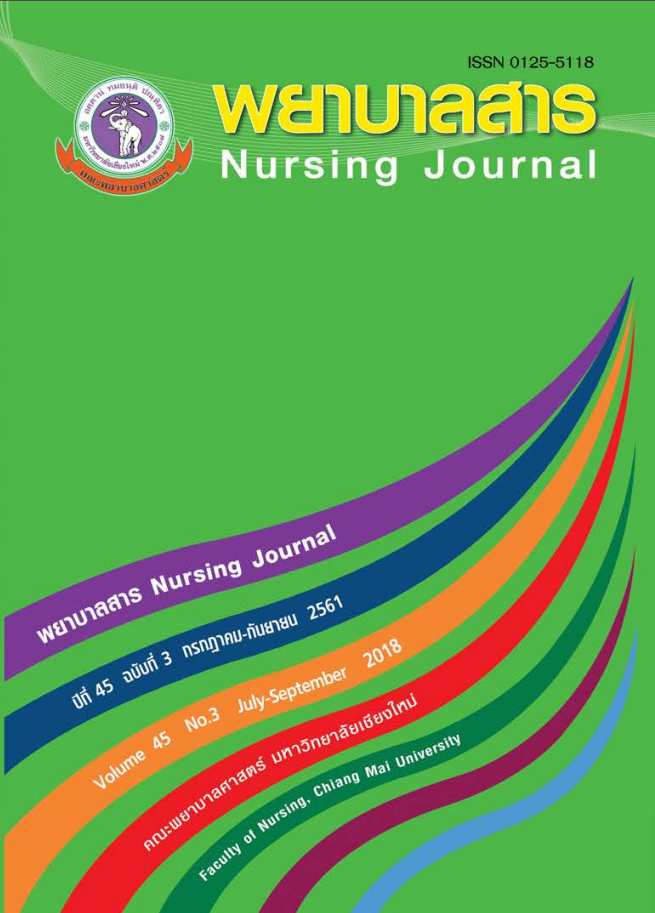Situation of Trauma Death and Management Prior to Death
Keywords:
Trauma death, Management prior to deathAbstract
Proper care of persons with severe traumatic injuries and life-threatening conditions from pre-hospital to trauma center can decrease possible preventable death and preventable death. This retrospective descriptive study aimed to study situation of trauma death and management prior to death. Samples consisted of data of 102 traumatic injured persons who died during receiving care on scene, during transfer to hospital or from hospital to hospital, or in trauma center level 1 from January 2011 to December 2013. Instruments used for data collection included the situation of trauma death record form and the management prior to death record form, developed by the researcher based on the Advanced Trauma Life Support framework and literature review. Descriptive statistics were used for data analysis.
The study results showed that trauma death were mostly caused by traffic accidents (86.28%). The most common injured sites were head and neck (49.02%). Hemorrhage was the most common cause of death (46.08%). Means of the Injury Severity Score, the Revised Trauma Score, and the Trauma Score-Injury Severity Score were 24.29 (S.D. 10.85), 0.92 (S.D. 1.92) and 0.18 (S.D. 0.22), respectively. Management of airway, breathing, and circulatory system prior to death during pre-hospital, during transfer from hospital to hospital, and in trauma center were mostly appropriate. Inappropriate managements of airway, breathing, and circulatory system during pre-hospital period were 22.22%, 22.22% and 11.11%, respectively, and during transfer from hospital to hospital were 5.88, 11.76, and 35.29, respectively. In trauma center, there were 37.25% of inappropriate management of circulatory system. This study results can be used as a basis for further effective improvement of trauma care system.
References
American College of Surgeons, & Committee on Trauma. (2012). Advanced trauma life support: student course manual. Chicago, IL: American College of Surgeons.
Chalkley, D., Cheung, G., Walsh, M., & Tai, N. (2011). Deaths from trauma in London--a single centre experience. Emergency Medicine Journal, 28(4), 305–309. doi:10.1136/emj.2009.085613
Chiara, O., Scott, J. D., Cimbanassi, S., Marini, A., Zoia, R., Rodriguez, A., … Milan Trauma Death Study Group. (2002). Trauma deaths in an Italian urban area: an audit of pre-hospital and in-hospital trauma care. Injury, 33(7), 553–562.
Haut, E. R., Kalish, B. T., Cotton, B. A., Efron, D. T., Haider, A. H., Stevens, K. A., … Chang, D. C. (2011). Prehospital Intravenous Fluid Administration Is Associated With Higher Mortality in Trauma Patients: A National Trauma Data Bank Analysis. Annals of Surgery, 253(2), 371–377. doi:10.1097/SLA.0b013e318207c24f
Henry, J. A., & Reingold, A. L. (2012). Prehospital trauma systems reduce mortality in developing countries: A systematic review and meta-analysis. Journal of Trauma and Acute Care Surgery, 73(1), 261–268. doi:10.1097/TA.0b013e31824bde1e
Johansson, P. I., Stensballe, J., & Ostrowski, S. R. (2012). Current management of massive hemorrhage in trauma. Scandinavian Journal of Trauma, Resuscitation and Emergency Medicine, 20, 47. doi:10.1186/1757-7241-20-47
Maio, R. F., Burney, R. E., Gregor, M. A., & Baranski, M. G. (1996). A study of preventable trauma mortality in rural Michigan. The Journal of Trauma, 41(1), 83–90.
O’Reilly, D., Mahendran, K., West, A., Shirley, P., Walsh, M., & Tai, N. (2013). Opportunities for improvement in the management of patients who die from haemorrhage after trauma: Management of patients who die from haemorrhage after trauma. British Journal of Surgery, 100(6), 749–755. doi:10.1002/bjs.9096
Sanddal, T. L., Esposito, T. J., Whitney, J. R., Hartford, D., Taillac, P. P., Mann, N. C., & Sanddal, N. D. (2011). Analysis of preventable trauma deaths and opportunities for trauma care improvement in Utah. The Journal of Trauma, 70(4), 970–977. doi:10.1097/TA.0b013e3181fec9ba
Settervall, C. H. C., Domingues, C. de A., Sousa, R. M. C. de, & Nogueira, L. de S. (2012). Mortes evitáveis em vítimas com traumatismos. Revista de Saúde Pública, 46(2), 367–375. doi:10.1590/S0034-89102012005000010
Shackford, S. R., Hollingsworth-Fridlund, P., McArdle, M., & Eastman, A. B. (1987). Assuring quality in a trauma system--the Medical Audit Committee: composition, cost, and results. The Journal of Trauma, 27(8), 866–875.
World Health Organization. (2004). Guidelines for essential trauma care. (C. Mock, Ed.). Geneva: World Health Organization.
World Health Organization. (2010). Injuries and violence: the facts. (Vol. 2010). Retrieved from http://whqlibdoc.who.int/publications/2010/9789241599375_eng.pdf
Translated Thai References
Kamonthip Sae-lao. (2010). National master plan of emergency medical services 2010 – 2012.
Retrieved from http://www.niems.go.th/th/View/Page.aspx?PageId=25560110044324868
Kesara Kawong. (2013). Barriers of providing emergency medical services for trauma
persons at Lampang hospital. (Independent Study, Master of Nursing Science [Adult Nursing]). Graduate school, Chiang Mai university.
Natcha Hansudewechakul, Boriboon Chenthanakij & Borwon Wittayachamnankul. (2012). Why don’t Chiangmai people in need call emergency medical service, Journal of Health Systems Research. 6(2), 268–277.
Paiboon Suriyawongpaisarn (2011). Situation of road safety in Thailand 2010. Bangkok.
National institute for emergency medicine. (2013). Terms, conditions and certification for emergency medical services personals (1st ed.).
Strategy and planning division, Ministry of public health. (2012). Death statistics 2007 - 2011. Nonthaburi.
Bureau of Epidemiology, Department of Disease Control Ministry of Public Health (2012). Surveillance for Non-Communicable Disease. Retrieved from http://www.boe.moph.go.th/report.php?cat=11
Sanchai chasombat. (2012). National master plan of emergency medical services 2013 – 2016
Retrieved from http://www.niems.go.th/th/Upload/File/255604221127228070_K3cYvqY9z2jy5KHg.pdf
Downloads
Published
How to Cite
Issue
Section
License
บทความที่ได้รับการตีพิมพ์เป็นลิขสิทธิ์ของวารสารพยาบาลสาร
ข้อความที่ปรากฏในบทความแต่ละเรื่องในวารสารวิชาการเล่มนี้เป็นความคิดเห็นส่วนตัวของผู้เขียนแต่ละท่านไม่เกี่ยวข้องกับมหาวิทยาลัยเชียงใหม่ และคณาจารย์ท่านอื่นๆในมหาวิทยาลัยฯ แต่อย่างใด ความรับผิดชอบองค์ประกอบทั้งหมดของบทความแต่ละเรื่องเป็นของผู้เขียนแต่ละท่าน หากมีความผิดพลาดใด ๆ ผู้เขียนแต่ละท่านจะรับผิดชอบบทความของตนเองแต่ผู้เดียว






